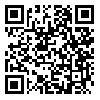Volume 5, Issue 1 (2017)
Health Educ Health Promot 2017, 5(1): 67-78 |
Back to browse issues page
Download citation:
BibTeX | RIS | EndNote | Medlars | ProCite | Reference Manager | RefWorks
Send citation to:



BibTeX | RIS | EndNote | Medlars | ProCite | Reference Manager | RefWorks
Send citation to:
Seyedi-Andi S J, Borhani M, Koshki G, Fadaei E, Saber M, Mehri A. Effect of Education on Choosing Delivery Mode among Pregnant Women Referred to Health Centers of Minoodasht City: An Application of BASNEF Model. Health Educ Health Promot 2017; 5 (1) :67-78
URL: http://hehp.modares.ac.ir/article-5-12379-en.html
URL: http://hehp.modares.ac.ir/article-5-12379-en.html
Seyed Jalil Seyedi-Andi1, Mahboobe Borhani *2, Godarz Koshki3, Ebrahim Fadaei4, Maryam Saber5, Ali Mehri6
1- Assistant Professor in Health Education and Health Promotion, Social Determinants of Health Research Center, Health Research Institute, Babol University of Medical Sciences. Babol, Iran, Babol
2- Ph.D. in Health Education and Health Promotion, Health Management and Social Development Research Center, Golestan University of Medical Sciences, Gorgan, Iran
3- MD, Health Management and Social Development Research Center, Golestan University of Medical Sciences, Gorgan, Iran
4- MD, Health Management and Social Development Research Center, Golestan University of Medical Sciences, Minoodasht, Iran
5- Ph.D. in Health Education and Health Promotion, Assistant Professor, School of Public health, Kerman University of Medical Sciences, Kerman, Iran
6- Ph.D. in Health Education and Health Promotion, Assistant Professor, School of Public Health, Sabzevar University of Medical Sciences, Sabzevar, Iran
2- Ph.D. in Health Education and Health Promotion, Health Management and Social Development Research Center, Golestan University of Medical Sciences, Gorgan, Iran
3- MD, Health Management and Social Development Research Center, Golestan University of Medical Sciences, Gorgan, Iran
4- MD, Health Management and Social Development Research Center, Golestan University of Medical Sciences, Minoodasht, Iran
5- Ph.D. in Health Education and Health Promotion, Assistant Professor, School of Public health, Kerman University of Medical Sciences, Kerman, Iran
6- Ph.D. in Health Education and Health Promotion, Assistant Professor, School of Public Health, Sabzevar University of Medical Sciences, Sabzevar, Iran
Abstract: (4631 Views)
Aim: Caesarean section is dramatically increasing across the world. Pregnant women have an increasing tendency for caesarean section without acceptable medical indications. In general, 50 to 60% of childbirths in Iran are cesarean section. Despite the high complications of cesarean section, they are not caused by medical problems. Therefore, the current survey aims to screen the effect of education on choosing delivery mode based on BASNEF model.
Methods: A quasi-experimental study was done on 160 nulliparous women in the third trimester of pregnancy who were assigned randomly to the intervention (80 subjects) and control (80 samples) groups. A researcher-made questionnaire was utilized to collect the required data. Education and its content were developed according to the BASNEF model and the pregnant women's educational requirements. Numerous education methods were implemented in all target groups of intervention including pregnant women, their family and the health staffs. To analyze the data, paired and McNemar tests through SPSS version 18 were utilized. Significant level was also considered <0.05.
Findings: The majority of women were in the age range of 24-20 years. Only 1.2% of the women were illiterate in both groups. Knowledge, attitude, enabling factors, subjective norms and intention were significantly different between the two arms before and 2 months after the intervention (p=0.001) except for intention. In addition, in the intervention group, they get information significantly from friends, families, printed materials, educational films, educational sessions in the Health Centers, and the health personnel after the intervention (p=0.001).
Conclusion: Designing educational programs about delivery mode based on BASNEF model appeared to be beneficial due to the model‟s emphasis on subjective norms and enabling factors; therefore, educational programs based on change behavior model can notably decrease the unnecessary cesarean section in the country.
Methods: A quasi-experimental study was done on 160 nulliparous women in the third trimester of pregnancy who were assigned randomly to the intervention (80 subjects) and control (80 samples) groups. A researcher-made questionnaire was utilized to collect the required data. Education and its content were developed according to the BASNEF model and the pregnant women's educational requirements. Numerous education methods were implemented in all target groups of intervention including pregnant women, their family and the health staffs. To analyze the data, paired and McNemar tests through SPSS version 18 were utilized. Significant level was also considered <0.05.
Findings: The majority of women were in the age range of 24-20 years. Only 1.2% of the women were illiterate in both groups. Knowledge, attitude, enabling factors, subjective norms and intention were significantly different between the two arms before and 2 months after the intervention (p=0.001) except for intention. In addition, in the intervention group, they get information significantly from friends, families, printed materials, educational films, educational sessions in the Health Centers, and the health personnel after the intervention (p=0.001).
Conclusion: Designing educational programs about delivery mode based on BASNEF model appeared to be beneficial due to the model‟s emphasis on subjective norms and enabling factors; therefore, educational programs based on change behavior model can notably decrease the unnecessary cesarean section in the country.
Article Type: Original Article |
Subject:
Theory and Model in Health Education and Promotion
Received: 2017/08/3 | Accepted: 2017/03/1 | Published: 2017/09/17
Received: 2017/08/3 | Accepted: 2017/03/1 | Published: 2017/09/17
| Rights and permissions | |
 |
This work is licensed under a Creative Commons Attribution-NonCommercial 4.0 International License. |





